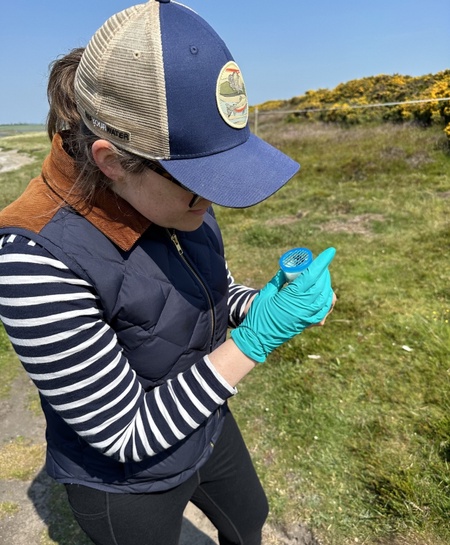As you walk the aisles of your local grocery store, you are balancing a multitude of internal and external factors that together influence your food decisions. Your personal preferences, family eating history, and receptivity to advertising comingle with internal signals indicating your level of hunger or any nutritional deficiencies you may be experiencing. While their preferred food depot is the nearby wildflower meadow rather than the corner Tesco, pollinating insects balance many of the same factors when making food choices.
Insect pollinators evaluate each flower for its value. Is it at its peak? Is its reward physically available to them (flowers differ in shape, size, and presentation to allow access to different pollinators)? Has the flower recently been depleted by another visitor? And they must consider who they are feeding. Themselves? Or their larval sisters back at the nest, ensuring the future strength of their kin. To help evaluate their choices, insect pollinators use their past experiences and, for social bees, feedback they receive from their sisters.
They also use their senses. Bees show visual preferences for certain colours and shapes, and they use their sense of smell. Flowers know this. Floral scents serve to manipulate the behaviour of their visitors, attracting pollinators while repelling damage-causing herbivores. A subtler but no less important signal comes from the reward itself. Taste! The layers of signals communicated through nectar taste have only begun to be explored, but like scent, recent studies have shown that certain flowers spike their nectar with secondary metabolites that may also serve to direct the behaviour of pollinators – caffeine for short-term memory bursts, nicotine to prevent visitors from over-indulging, and, perhaps, specific micronutrients to sweeten the deal.
Unlike carnivores, insect herbivores and nectivores (those that drink flower nectar) struggle to find sufficient sodium in their diet, and salt-seeking behaviour has been observed in several pollinators (e.g., puddling in butterflies, drinking brackish water in honeybees). Offering more direct evidence, a recent study demonstrated strong preference among pollinators of several insect groups for flowers treated with sodium-spiked sugar solution. These natural observations and experimental findings have led some to suggest that flowers may use micronutrients — including sodium — like they do secondary metabolites, controlling behaviour by encouraging would-be pollinators while repelling undesirables such as nectar robbers and insect herbivores. For the bee, she is unaware that her food choices are being manipulated by eons of plant-pollinator co-evolution. Just like most people are unaware that they have been primed through advertising when they pick up that extra bag of crisps or tin of biscuits.
Unique to the north- and west-facing soft coasts of Scotland and the Republic of Ireland, machair habitats are a refuge for communities of rare and declining bee pollinators. Totalling only 25-30,000 ha, machair is home to over 70 species of insect pollinator including the nationally endangered Great Yellow Bumblebee (Bombus distinguendus). Once found throughout Great Britain, this species is now restricted to patches of machair dotting Scotland’s islands (Figure 1). Previous investigations into what makes this habitat particularly attractive to rare bees like B distinguendus have focused on food plant abundance and diversity – how many ‘food depots’ of sufficient size and quality are available to them. Few have explored the underlying nutritional landscape of machair wildflowers. However, given the high environmental availability of sodium and other marine nutrients, it isn’t a far leap to suggest that one potential mechanism of pollinator attraction and support by machair flowering plants is the conversion of environmental elements into micronutrient rewards. That is the question this research intends to answer: Do machair flowers encourage visitation by bee pollinators by facultatively ‘spiking’ their nectar with sodium and other micronutrients? And, if so, is there an optimal combination of sugars and micronutrients for bee nutrition? Does this optimal combination vary between bee species or even individuals?
Supported in part by the Sutherland Scholarship, between 23 June and 23 August 2023, 20 hours of behavioural data, 200 foraged pollen and nectar samples, and over 500 plant samples (plant tissues, nectar, and pollen) were collected from sites on five of Scotland’s machair-rich islands: North Uist, South Uist, Isle of Coll, Isle of Tiree, and Sanday, Orkney (Figure 2, Table 1). Using element identification techniques to be performed over the next few months at the University of Aberdeen Environmental Analysis Lab, these samples will be analysed to establish a baseline for sodium and other micronutrients (potassium, calcium, magnesium) among machair flowering plants of these islands. This baseline will then be used for comparisons with observed foraging bouts and with quantities of these elements in nectar and pollen selectively foraged by target bee species.
Ultimately, this research will help characterise the role of vital micronutrients in facilitating the plant-pollinator networks that support Great Britain’s rare bees. Results from this research will add to the growing literature on the chemical ecology of plant-pollinator interactions and help us unpack another layer of the complex decision-making bees perform when picking their meals. Just like you on a hungry shopping trip!


